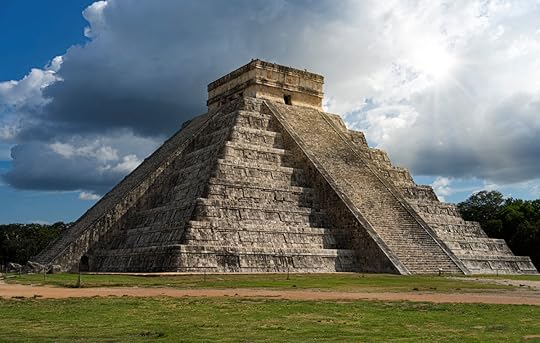Ripley Entertainment Inc.'s Blog, page 22
June 16, 2023
CARTOON 06-16-2023
June 15, 2023
400+ Ancient Maya Cities Connected by “Superhighways”
Featured in Ripley's Believe It or Not!

President Dwight D. Eisenhower signed legislation to fund the U.S. Interstate Highway System (IHS) on June 29, 1956. This move satisfied a decades-old dream of uniting the nation from “sea to shining sea.” It also killed a couple of birds with one stone. First, it provided escape routes for Americans should the Cold War deteriorate into a nuclear conflict. Second, it let Eisenhower capitalize on lessons learned from Europe’s Autobahn and the First Transcontinental Motor Convoy.
Eisenhower’s efforts birthed Route 66, one of the niftiest developments to hit post-World War II America. And it sparked a car-culture wildfire that continues to burn today. Think Fast and Furious, Gone in 60 Seconds, and Ford v Ferrari.
But scientists recently revealed America has nothing on Mesoamerica regarding the first superhighways. Here’s what you need to know about the ancient transportation network that once united 400+ Maya cities.
All Roads Lead to El MiradorThe sophistication of some ancient Mesoamerican civilizations continues to astound researchers. One of their most recent discoveries could rewrite Mexico’s early history. All roads lead figuratively and literally to Guatemala’s El Mirador jungle.
There, LiDAR (light, detection, and ranging) technology has uncovered 417 Maya cities dating to 1000 B.C. and interconnected with 110 miles of superhighways. Richard Hansen of Idaho State University explains, “We now know that the Preclassic period was one of extraordinary complexity and architectural sophistication, with some of the largest buildings in world history being constructed during this time.”
@worldeconomicforum This could have been the world’s first highway network. Tap the link in our bio for more #ancient #history #mayan #civilisation #mexico #guatemala ♬ original sound – World Economic Forum
That’s a nice way of saying these discoveries have upturned what we know about Maya Civilization. Until recently, the Maya were considered nomadic, pre-agrarian hunter-gatherers in 1000 B.C. But their vast cities and interconnecting highways point to massive, complicated public works projects centuries before Eisenhower was a twinkle in his mother’s eye. Hansen elaborates, “[These discoveries reveal] a whole volume of human history that we’ve never known.”
Archaeology’s Disruptor: LiDAR TechBefore LiDAR technology, Mesoamerican researchers relied on hand-drawn renderings to map out places of perceived historical importance. But LiDAR has changed the game since its first introduction in 2015. To say the pre-LiDAR drawings left much to be desired is an understatement.
LiDAR has helped researchers map out vast complexes featuring reservoirs, platforms, pyramids, dams, and ball courts. These discoveries have ramped up the learning curve when it comes to how the Maya interacted and structured themselves politically and socially. But how do the 417 cities and superhighways in the jungles of El Mirador compare to other ancient sites worldwide?
Enrique Hernández of San Carlos University in Guatemala City argues these discoveries will prove as groundbreaking as the Egyptian pyramids. Having spent the last two decades excavating at El Mirador, he’s got the knowledge to back up his claims. LiDAR represents just the kind of disruptive technology that archaeology needs. One that’s already contributed exponentially to pinpointing 3,000-year-old Maya superhighways and cities.
Once upon a time, it took a decade to locate a mere 50 important jungle sites. Now, more than 900 settlements have been identified with significant historical repercussions. Most people are familiar with the adage, “All roads lead to Rome.” But the ancient Italian empire remained in its infancy in 1000 B.C. Perhaps, the more apt phrase would be, “All roads lead to El Mirador.”
By Engrid Barnett, contributor for Ripleys.com
EXPLORE THE ODD IN PERSON! Discover hundreds of strange and unusual artifacts and get hands-on with unbelievable interactives when you visit a Ripley’s Odditorium!Source: 400+ Ancient Maya Cities Connected by “Superhighways”
CARTOON 06-15-2023
June 14, 2023
The Incredible Story Of The Students Who Stole The Stone Of Destiny
Featured in Ripley's Believe It or Not!

It’s almost Christmas 1950, and while most folks are merrily sipping their eggnog at home, four Glasgow students with a burning passion for Scottish nationalism are about to pull off the heist of the century.
To understand how things got to that point, we need to go back a few centuries. Enter the Stone of Destiny (also known as the Stone of Scone), a 336lb slab of pale-pink sandstone that had been used in the coronation of Scottish kings for centuries. Legends about it abound — perhaps the stone is the Biblical Jacob’s Pillow, perhaps it was part of the Roman Antonine Wall.
Either way, King Edward I stole it from the Scotts during the Independence Wars in the 13th century and brought it to England’s Westminster Abbey — where this unassuming block of stone was mounted under an oak coronation chair and, you guessed it, used during the coronation of English monarchs from then on.
Enter the Stone RaidersSo let’s go back to December 1950, when a team of four Scottish students (Ian Hamilton, Kay Matheson, Gavin Vernon, and Alan Stuart) set out to “reclaim” the stone and bring it back home.
Embed from Getty Imageswindow.gie=window.gie||function(c){(gie.q=gie.q||[]).push(c)};gie(function(){gie.widgets.load({id:'qoV_nuxSR_1SK2fR3x2vBQ',sig:'KnUFmKz2SN10dN4VDHbBK7n6Kggt8BIEamPJTUFU2co=',w:'375px',h:'594px',items:'72963599',caption: true ,tld:'com',is360: false })});This wasn’t an easy task and on the first night they tried breaking into Westminster Abbey, Hamilton was caught by a security guard — who let him off with a warning. The group returned on Christmas Day and this time, it all worked out so well, it was almost like an old Hollywood heist movie. After jimmying the Abbey’s door open in the middle of the night, the group managed to remove the stone from under the throne — only to have it break in two.
In a bit of a panic, Hamilton grabbed the smaller 90lbs piece and ran out of the Abbey — only to realize he had lost his car keys inside the Abbey. So back in he went, grabbing not only his keys but also the larger piece of stone they had left behind.
Hide and Stone-SeekQuickly realizing the whole thing could have serious consequences, the group decided to hide the stone. The larger piece was buried near Kent, while the smaller bit found a temporary home in a Birmingham garage. Soon, police were out in force searching for the stone and looking for “a man and a woman in a Ford Anglia car… with Scottish accents.”
Despite the chaos and uproar, however, the police were not able to find any trace of it, and Hamilton and the gang eventually moved it to Scotland and gave it to the Scottish Covenant Association (an organization campaigning for a Scottish Parliament) for safekeeping.
The Association soon decided the now-repaired stone should be returned since it had already served its purpose (serve as a symbol of Scottish independence) and left it at the ruins of Arbroath Abbey, from where it was then transported back to England and eventually became part of Queen Elizabeth II’s coronation in 1953.
Thieves? More Like National HeroesThe stone was eventually returned to Scotland in 1996 and now resides in its rightful home inside Edinburgh Castle.
Despite all the trouble, the daring thieves were never charged because “no one had been harmed, even if the stone had a bumpy ride.”
Embed from Getty Imageswindow.gie=window.gie||function(c){(gie.q=gie.q||[]).push(c)};gie(function(){gie.widgets.load({id:'grOmgc8ZRQt6g212N6IyFA',sig:'Ju0uBYXcj61gojp497QX_b0yTNrPb5zOGhIvDQSZJ1g=',w:'594px',h:'396px',items:'1252346561',caption: true ,tld:'com',is360: false })});Hamilton went on to become a successful criminal lawyer who continued to campaign for self-government in Scotland. He died in 2022 at the age of 97, just months before the coronation of King Charles III in May 2023. For the grand event, the Stone of Destiny traveled back to London, where it was once again placed under the coronation chair to welcome the new king — and then returned to Scottland right after the ceremony.
One can only hope this ride was a lot less bumpy than the previous one.
By Diana Bocco, contributor for Ripleys.com
EXPLORE THE ODD IN PERSON! Discover hundreds of strange and unusual artifacts and get hands-on with unbelievable interactives when you visit a Ripley’s Odditorium!Source: The Incredible Story Of The Students Who Stole The Stone Of Destiny
CARTOON 06-14-2023
June 13, 2023
After While Crocodile: 120-Year-Old Cassius Paves The Way For Longevity
Featured in Ripley's Believe It or Not!

When it comes to the world’s longest-lived animals, you’ll find incredible variety. For example, the Earth’s oldest land animal is Jonathan, a Seychelles giant tortoise, born somewhere around 1832 and aged 190 in 2022.
Surprisingly, Jonathan has nothing on a quahog clam estimated to be more than 500 years old. The most aged primate in history was Cheeta the chimpanzee, who lived to be 80 years old. And don’t forget about the Greenland shark, which can live for nearly four centuries!
Now, we can add another old-timer to the mix, Cassius, an Australian crocodile best described as “big, old, and gnarly.” Keep reading for the lowdown on this 120-year-old reptile and what he’s teaching the scientific community about long life.
The Record-Crushing CrocodileCassius may not be the most gorgeous critter on the planet. But that hasn’t stopped him from slaying well into his second century. The scaly old lizard first gained acclaim due to his size. At nearly 18 feet long, the saltwater crocodile (Crocodylus porosus) has outgrown even his biggest wild rivals.
Cassius the Croc, who holds the record for the largest crocodile, just hit his 120th birthday. #cassius #croc #guinness #worldrecord #crocodiles #crocodile #australia #australian #wildlife #news #cassiusthecroc #guinnessworldrecord #queensland pic.twitter.com/4UmkzJiI34
— Empact News (@EmpactNews) June 5, 2023
For example, in 2018, a saltwater croc turned up Down Under, sporting a 15.4-foot-long body. But he didn’t hold a candle to Cassius, who boasts the planet’s record (since 2011) for the largest captive crocodile. Emphasis on “captive.” That said, he’s still got a handful of feet to stretch before becoming the most enormous saltwater croc of all time. That record goes to Lolong, a more than 20-foot-long monster in the Philippines.
Capturing Toothy CassiusHow did researchers capture Cassius in the first place? It all started at a cattle ranch in Darwin, Australia, in 1984. Put simply, cows and crocs didn’t mix well, which left Cassius in a pickle.
Crocodile researchers, including Grahame Webb, participated in the roundup operation that resulted in Cassius’s captivity. Webb recalls Cassius’s impressive size at the time, coming in at a whopping 16 feet, 10 inches. The largest of his species ever captured alive. Researchers estimated Cassius’s age at between 30 and 80 years old based on his size.
Cassius Flourishes in CaptivityOnce settled into captivity, Cassius did the unthinkable. He kept growing, soon stretching to nearly 18 feet. His continued growth went against the grain, offering scientists “serious knowledge on longevity.” And now he can add great age to the mix, having recently turned an estimated 120 years. (Give or take half a century.)
What else distinguishes Cassius from other reptiles? His personality! Unlike other elderly crocs that tend to slow down and get docile over time, Cassius remains a fireball. Toody Scott, a crocodile keeper at Marineland Crocodile Park on Green Island, notes, “He still has a lot of spark in him [and is] always up for an interaction. He’s one of the liveliest crocs and very engaging.”
Here’s to another 120 years, Cassius!
By Engrid Barnett, contributor for Ripleys.com
EXPLORE THE ODD IN PERSON! Discover hundreds of strange and unusual artifacts and get hands-on with unbelievable interactives when you visit a Ripley’s Odditorium!Source: After While Crocodile: 120-Year-Old Cassius Paves The Way For Longevity
CARTOON 06-13-2023
June 12, 2023
CARTOON 06-12-2023
June 11, 2023
CARTOON 06-11-2023
June 10, 2023
CARTOON 06-10-2023
Ripley Entertainment Inc.'s Blog
- Ripley Entertainment Inc.'s profile
- 52 followers










